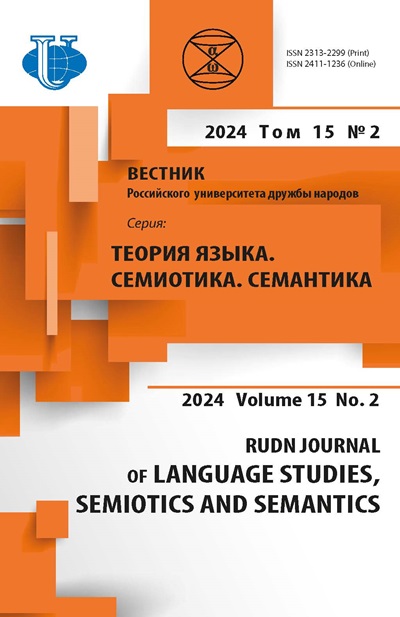PHONOSTYLISTIC PLAY ON WORDS IN LITERARY FAIRY TALES: SEMIOLOGICAL ASPECT
- Authors: Orlova O.Y.1
-
Affiliations:
- Ural Federal University named after the First President of Russia B.N. Yeltsin
- Issue: Vol 8, No 3 (2017)
- Pages: 694-702
- Section: Articles
- URL: https://journals.rudn.ru/semiotics-semantics/article/view/17031
- DOI: https://doi.org/10.22363/2313-2299-2017-8-3-694-702
Cite item
Full Text
Abstract
The article considers phonographical stylistic devices in literary fairy tales by English and American authors. The aim of the article is to demonstrate the potential of semiotic strategies in children’s literature. To achieve this aim the author consistently examines various phonographic devices used in the texts of literary fairy tales and analyses both the specific features of the relation between the signifier and the signified and the meaning of the given device in the formation of the specific literary code of the text for children by means of which the author plays with the reader. The author used as the material classic works by L.F. Baum, L. Carroll, A.A. Miln, C. Sandburg, J. Thurber, R. Dahl, which fully represent genre features of English and American literary fairy tale. Building on the functional-semiotic approach, the author reveals that being an essential feature of the fairy tale genre, play on words may be based both on the simi-larity and arbitrariness of relationships between the signifier and the signified of the graphical sign. A sign in a text for children can also be incorporated into a new code, which the reader is to solve in order to inter-pret the whole text or its part correctly. The analysis reveals that phonographical stylistic devices in children’s literature perform different functions (creative, esthetic entertaining etc.), didactic function being one of the most important of them, since these techniques in books for young readers, among other things, serve as a means of mastering the alphabet and rules of reading.
About the authors
Olga Yu Orlova
Ural Federal University named after the First President of Russia B.N. Yeltsin
Author for correspondence.
Email: orlova_82@inbox.ru
Orlova Olga Yuryevna, PhD student, Department of Germanic Philology, Ural Federal University named after the First President of Russia B.N. Yeltsin; Scientific Interests: phonostylistics, semiotics, text linguistics
51, Lenina str., Yekaterinburg, Russia, 620000References
- Baum, L.F. (2007). The wonderful land of OZ: fairy tale. Novosibirsk: Sibirskoye universitet¬skoye izdatelstvo. (in Russ).
- Carroll, L. (1991). Alice’s adventures in Wonderland. Through the looking-glass and what Alice saw there. Мoscow: Nauka. (in Russ).
- Carroll, L. (2015). Alice’s adventures in Wonderland. Through the looking-glass. Moscow: IKAR.
- Garanina, Ye.A. (1998). Linguistic means of expression of the comic in children’s literature [doctoral dissertation abstract]. Volgograd: Volgograd State Pedagogical University. (in Russ).
- Kruzhkov, G. Fairy tales. URL: http://kruzhkov.net/fairytales (accessed: 21.05.2016). (in Russ).
- Lerer, S. (2008). Children's Literature: A Reader's History from Aesop to Harry Potter. Chicago: University of Chicago Press.
- Miln, A. (1983). Books about Winnie-the-Pooh. Verses for children. Collection. Moscow: Ra¬duga (in English).
- Miln, A. (1992). Winni-the-Pooh and All, all, all (And much more). Izhevsk; Moscow: Strannik; Avtorskaya pesnya. (in Russ).
- Sandburg, C. (1990). Rootabaga Stories. In: T.D. Venediktova (Ed.), American literary fairy tale: A collection (95—189). Moscow: Raduga.
- Thurber, J. (1990). The White Deer. In: T.D. Venediktova (Ed.), American literary fairy tale: A collection (191—233). Moscow: Raduga.
- Thurber, J. (2009). Wonderful O. New York: The New York Review of Books.
- Tsikusheva, I.V. (2010). Lingvo-stylistic characteristics of the comic in literary fairy tale [doctoral dissertation abstract]. Maykop: Adyge State University. (in Russ).













